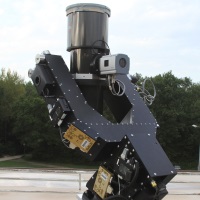Hunting for super-Earths with the Next Generation Transit Survey (NGTS)

Tuesday 17th March, 2015
 |
Our speaker, Dr Peter Wheatley from Warwick University, came to update us on his search for extrasolar planets. He had visited us previously in 2005 when he told us all about his project named WASP (Wide Angle Search for Planets) and now he was able to tell us all about his next endeavour the Next Generation Transit Survey (NGTS).
Dr Wheatley began his talk, "Hunting for super-Earths with the Next Generation Transit Survey, with a quote from the late Carl Sagan — "Look again at that dot. That's here. That's home. That's us." Dr Sagan was referring to Earth in an image taken by the Voyager 1 spacecraft from 6 billion km away, and Dr Wheatley used it to show how relatively isolated we were from distant stars and their surrounding planets. He explained that not only was it difficult to make out any details of our nearest stars but that the very starlight that made them visible rendered any orbiting planets invisible, hidden in the glare.
One method to search for exoplanets images them directly using infrared wavelengths where the planets are brighter compared with their star and an occulting disc is used to block the light from the central star. However, this is still very difficult and most detection techniques use an indirect method. The most popular methods are either to observe a planet transiting the star's disc or to record a slight wobble in the central star caused by the orbiting planets.
As the title of his talk suggests, Dr Wheatley's team use the transit method whereby a planet crosses the star's disc causing its light output to drop temporarily. From the data they are able to discern the relative sizes of the star and planet, some information about the planet's atmosphere, the eccentricity of the planet's orbit and in some cases its approximate temperature. For many exoplanets these planetary properties are only possible or can be enhanced by the other detection method that observes the star's wobble as the orbiting planet or planets pull on their central star.
So far, Dr Wheatley's exoplanets seem to fall into three categories: hot Jupiters, Jupiters, and warm Neptunes and super-Earths. The hot Jupiters are exoplanets that are the size of our own Jupiter but are very close to their central star. They are thought to have had to formed further out but then migrated somehow closer to the main star. Warm Neptunes are the size of Neptune but a bit closer to their star than our own ice giant planet and super-Earth's are thought to be made of rocky material but much larger than our own planet.
The NGTS became operational in January 2015 and consists of an array of twelve 20-cm diameter robotic telescopes sited at the European Southern Observatory's Paranal Observatory in northern Chile where the dry clear mountain air gives incredible seeing conditions. Dr Wheatley is hoping that the NGTS will be able to discover exoplanets that are Neptune-sized or smaller, orbiting around bright stars. These discoveries will then be followed up by the much larger neighbouring telescopes on the site such as the Very Large Telescope which consists of four individual telescopes that each have a primary mirror 8.2 metres across.
This article was written for the club news column of the Stratford Herald. The actual lecture explained the subject at a deeper level.
